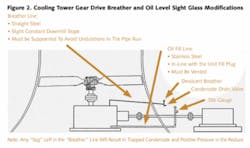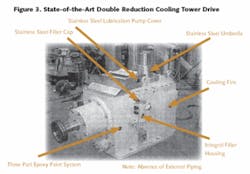Cooling Water: Improved Cooling Tower Maintenance
• The down-low on proper long-term operation of equipment placed up high courtesy of Philadelphia Gear
by Jules DeBaecke
Proper maintenance of cooling towers can be a dangerous, expensive and tedious undertaking. Here’s some information on ways to make the process easier.
The Cool, Hard Facts
A cooling tower’s components are complex, often requiring unique capabilities for meeting environmental and operational challenges. The unit’s fan drive systems usually reside within the cooling tower assembly, high above ground level, complicating simple maintenance tasks for tower operators.
The tower’s driving fan blades, often exposed to the elements, frequently become covered with ice, intensifying workloads for commodity gear drives. Lip seals installed on the input and output shafts of these gear drives become susceptible to malfunction (e.g., extreme wear, leakage, gear and bearing breakdown) when they don’t remain well-lubricated. Lubricating these components regularly and observing any deterioration proves difficult for operators due to the systems’ locations at such extensive heights. Additionally, experienced operators, able to detect impending commodity gear drive malfunctions by listening for indicative noises, can’t employ this useful practice because the equipment they observe is up too high. These logistical challenges inhibit the safety of operators performing maintenance on cooling towers, and limit the quality and frequency of their maintenance consequently, limiting their efficiency.
Currently, the use of remote equipment monitoring with vibration and temperature probes is the most effective means of circumventing this dilemma. While this equipment does warn operators of impending system failures and allow for preventative maintenance, it’s costly to own.
Fortunately, there are cost-effective measures to take when purchasing a cooling tower or improving an existing one.
Fighting Moisture
Enclosed gear drives must breathe on a regular basis for continuous pressure equalization and oil leakage prevention. In most cases, a commodity-type gearbox includes a commodity-type breather. This component is minimally efficient in equalizing air pressure between inner gear drive housings and the surrounding atmosphere. This often allows any moisture in the air to circulate through the gearbox and contribute to malfunction. These breathers can be easily upgraded to oil bath breathers which maintain adequate gear drive lubrication and prevent moisture accumulation.
Figure 3 illustrates that breathers can be fed through a pipe tee, and a second pipe can be angled for drainage of collected moisture from the unit. A small petcock, installed near the drive motor, can serve as a reservoir for the liquid that can be drained periodically. The system stores several days’ worth of moisture and prevents its backup into the gear drive housing.
By running another pipe from a cooling tower gear housing tap into the bottom half of the gear housing, and then out to the drive motor area, a remote oil sight gauge and fill tap can be installed in an area away from the tower’s fan blades. Oil levels can then be checked by operators from a safe location. With these minor piping modifications, operators can drastically reduce lack of lubrication and lubrication water contamination two major causes of cooling tower gearbox failures.
When It’s OK to Fake It
Replacing mineral oils with synthetic lubricants is another effective means for operators to maintain gear drive lubrication. Synthetic lubricants offer several key advantages over typical refined mineral oil products: They’re extremely difficult to break down due to their strong synthetic bonds, and they offer superior viscosity. While these oils can cost four to five times more than mineral-based oils, they are far more cost-efficient in the long run.
Getting All the Fixings
These value-added cooling tower features significantly reduce life cycle costs, and require modest up-front investments:
Anti-Corrosion Protection Enclosed gear drives usually operate in hot, moist environments, making corrosion protection for gear housings imperative. Use a self-curing, three-part paint system of zinc primer coat (2 to 3 milliliters thick); an intermediate epoxy coat (four to six mils thick); and an epoxy finish coat (3 to 4 ml thick) for several years of protection.
External Piping Eliminating external piping can prevent pipe breakage and bending malfunctions. Well-conceived cast housing designs allow room for bearing and gear mesh lubrication and cooling oil paths to be included within the housing, eliminating external lines.
Cooling Oil Systems Cooling tower gear drive lubrication systems can be made redundant by employing a dual system of dipping gears and/or flingers, and a shaft-driven oil pump supplying oil under pressure. Leaking seals are a primary cause of oil loss, and the redundant pump system thwarts catastrophic failure by continuously supplying oil to critical components during malfunction.
Filtration A built-in filter housing and oil ports under a stainless steel cover plate can be incorporated into housing castings. For quick changing, the cover plate is accessible from above the housing. The filter size can be made to accommodate changes during regular tower maintenance.
Cooling Fins These can also be added to the cast housing design with minimal addition of material. This significantly reduces gear housing skin temperature, increasing the service life spans of lip seals and lubrication oils.
High-End Shaft Seals Such seals have a longer service life and are more tolerant of misalignment. There are several mechanical face-type seal alternatives that can be incorporated into new designs, or be back-fitted into designs containing lip-type shaft seals:
• A face-type seal consists of rotating and static members that are separated by an oil film. Typically, one member is held against the other by a spring or magnetic force, and the members are separated by the oil film.
• Labyrinth seals use the same isolating technique as face-types, keeping out external contaminants, and keeping in oil.
Output Shaft Umbrellas An umbrella rotates with the output shaft and protects the shaft’s seal from direct contact with fluids like condensation, water spray or hoses used during cleanings.
Conclusion
While every option isn’t practical in every situation, many of these enhancements are, in fact, tremendously beneficial to operators seeking cooling tower gearboxes which generate little-to-no life cycle surprises, and are both reliable and economical in operation. They offer choices that can make towers cooler, indeed.
About the Author: Jules DeBaecke is vice president of engineering at Philadelphia Gear Corp.’s headquarters in King of Prussia, PA. A graduate of Drexel University, he joined the company in 1981 and has held multiple managerial posts. Prior to that, DeBaecke was employed by the Naval Ship Engineering Center, Philadelphia Division. Contact: 800-766-5120 or www.philagear.com




